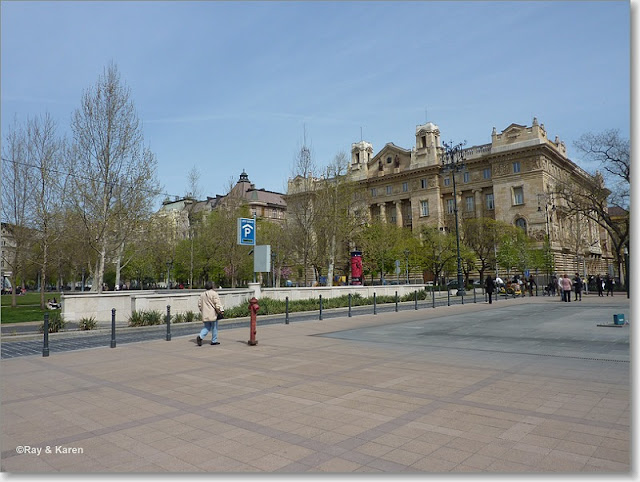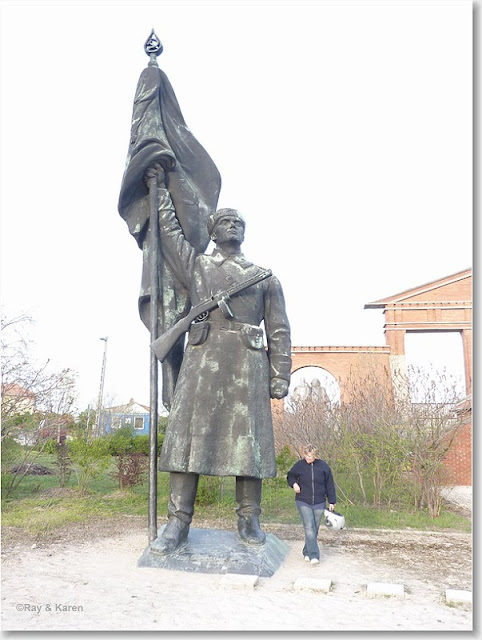We tried to make sense of the public transport system and failed miserably so we decided to go into Budapest on Wallace. We arrived at about noon after a 30 minute slow ride into town. Again, another very clean and proud place, spotless in fact.
 |
| Spotless and beautiful |
We spent about 10 minutes looking for a suitable place to park, not understanding a word of the parking signs. In the end we found an underground car park in the square opposite this:
 |
| Wallace was parked underneath us. |
We had searched the internet and found a small cruise company for a 1 1/2 hour trip up the Danube river to see most of the sights. First we needed a bank to get some cash out and struggled to work out how much we needed. The hungarians use a currency commonly called HUFs. There are 300 to the pound so the numbers are mindblowing.
We located the cruise office and bought the tickets. 7200 HUFs !
We were a bit early for the trip so we went for a coffee and found this mad place in the middle of a park cum square. They had a blow up bubble wall to protect customers from the cold whilst still alowing them to sit outside in the sunshine.
 |
| The bubble room cafe ! |
We then had a few minutes to spare and used then to good effect on the usual fridge magnet hunt. Success was intoxicating. A quck trip to the cruise office and an escorted trip to the boat. There were just 5 passengers including us for a boat big enough to take about 500 people.
needless to say the the trip was quiet and the promised comentary in 300 languages did not materialise.
Even so the view of Budapest was good. Here are the photos from the boat.
After the boat trip we decided to go for a walk along one of the roads in the "World Heritage" listand found the Royal Opera House.
 |
| Outside |
 |
| Inside - entrance hall |
 |
| This made us laugh |
After a while we got bored and tired so we extracted Wallace out of the underground car park and rode around the city.
We found these:
 |
| We later discovered it was an agrricultural museum so we were not too disapointed. |
There was a museum here, but guess what, it was shut. This "being shut" thing is starting to get tedious.
So, back on our trusty steed and out of the city towards our campsite. I had read in a pamphlet about a park with old relics from Lenin's Russian Rule era and I managed to identify its location which by luck was on the way home.
These are some photos of monuments
 |
| Vladimir Lenin |
 |
| Vladimir Lenin |
 |
| Here once stood Joseph Stalin. This is all that is left of his statue following the 1956 revolution. |
 | ||
| The famous "Trabant" or "Peoples Car". People had to order this 6 years in advance and pay half on ordering. First made in 1958. it has a body made of waste cotton and resin from cloth dye. |
Hungary has had a difficult past with Russian communism.
From Wikkipedia here is a short recent history from 1956 to present. (I think Trula will like this).
The Hungarian Revolution[4] of 1956 (Hungarian: 1956-os forradalom) was a spontaneous nationwide revolt against the government of the People's Republic of Hungary and its Soviet-imposed policies, lasting from 23 October until 10 November 1956.
The revolt began as a student demonstration which attracted thousands as it marched through central Budapest to the Parliament building. A student delegation entering the radio building in an attempt to broadcast its demands was detained. When the delegation's release was demanded by the demonstrators outside, they were fired upon by the State Security Police (ÁVH) from within the building. The news spread quickly and disorder and violence erupted throughout the capital.
The revolt spread quickly across Hungary, and the government fell. Thousands organized into militias, battling the State Security Police (ÁVH) and Soviet troops. Pro-Soviet communists and ÁVH members were often executed or imprisoned, as former prisoners were released and armed. Impromptu councils wrested municipal control from the ruling Hungarian Working People's Party and demanded political changes. The new government formally disbanded the ÁVH, declared its intention to withdraw from the Warsaw Pact and pledged to re-establish free elections. By the end of October, fighting had almost stopped and a sense of normality began to return.
After announcing a willingness to negotiate a withdrawal of Soviet forces, the Politburo changed its mind and moved to crush the revolution. On 4 November, a large Soviet force invaded Budapest and other regions of the country. Hungarian resistance continued until 10 November. Over 2,500 Hungarians and 700 Soviet troops were killed in the conflict, and 200,000 Hungarians fled as refugees. Mass arrests and denunciations continued for months thereafter. By January 1957, the new Soviet-installed government had suppressed all public opposition. These Soviet actions alienated many Western Marxists, yet strengthened Soviet control over Central Europe.
Public discussion about this revolution was suppressed in Hungary for over 30 years, but since the thaw of the 1980s it has been a subject of intense study and debate. At the inauguration of the Third Hungarian Republic in 1989, October 23 was declared a national holiday.
Before we arrived home, we went out for dinner. This is actually rare for us to do nowadays so it was a special event. We had a beer and a basic dish each. Total cost, just under 7000 HUF. Thats about £23. Our last meal in Venice, Italy was twice that cost for a small beer and a slice of pizza each.
This was us trying to figure our our money. We walked away with only the large note at the bottom.
 |
| How much !!!!! - £91 equivalent all together. |
Tomorrow the plan is to go north into the Slovak Republic and pop in to Bratislava and then carry on into Austria and visit Vienna. Thats the plan - who knows, it may just work out that way.

















Thanks for the wikki bit :-) lol and stay aways from them tescos thier taking over the world lol
ReplyDelete